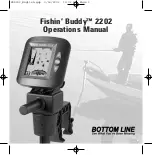
READING THE BOTTOM GRAPH
The bottom graph is created by drawing all of the echoes from a single burst in a vertical column
on the display, with the echoes from deepest objects drawn lowest on the display. After all the
echoes from the burst are drawn, the graph is shifted to the left and the process is repeated.
Grayscale
The Fishin’ Buddy™ 2202 uses a gray-checkered pattern to display the strongest signals, which
are usually from a hard bottom. Weaker signals above the bottom are displayed as black. This
allows you to separate the bottom from weeds and to differentiate a hard bottom from a soft,
muddy one. A soft bottom typically gives a thinner bottom image that is mostly black. A hard
bottom is displayed as a thin, black line over a much thicker area of checkered gray. Light weed
cover above the bottom will give a thicker, sketchy black area above the checkered gray.
Fish
To view the natural echoes from fish and other objects in the water, turn the fish alarm symbols
off. Many fishermen have heard that an arch is a good way of locating fish, but other objects you
troll across may also produce arches.
A better way of determining fish is to watch for subtle patterns on the graph. Solid horizontal lines
across the screen are often fish hovering under the transducer. These lines may go up and down,
suggesting some movement if they are fish. Generally, thicker marks come from larger fish. Clouds
of pixels are often schooling baitfish. Groups of diagonal lines are usually bubbles rising steadily
up from the bottom. As you get more familiar with the Fishin’ Buddy™ 2202 and the water that
you fish in, you will pick out many other patterns as well.
14
FB2202_English.qxp 3/14/2006 12:06 PM Page 15




























